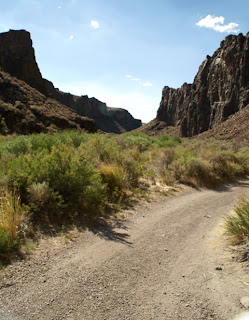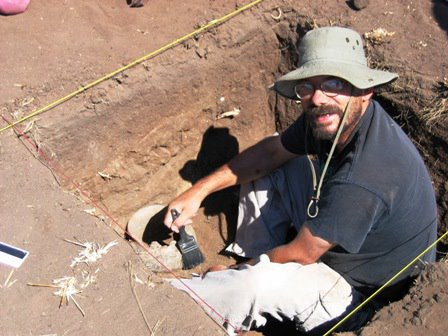
This is part of the Applegate emigrant trail through the High Rock Canyon in northwestern Nevada. The trail was established in 1846, offering emigrants an alternative to the northern routes along the Columbian river. Why anyone would want to travel this route by oxen-drawn wagon is beyond me. We were in 4WD much of the time and had to negotiate steep inclines and large boulders. Obviously, the emigrants improved the trail as they went, possessed infinitely greater patience than we exhibit today, and were, how shall we say it?…a lot tougher (natural selection acted on these folks in ways we could not fathom today). Nonetheless, the going was rough for the emigrants passing this way. Upon entering the canyon in 1849, J. Goldsborough Bruff remarked:
“We found that generally the bed of the stream was unavoidably the line of travel through this very rugged mountain pass. This pass, for trail there was none- was filled with stumps of Cotton Wood Trees, large fallen trees, stones and rocks of every size. Dead cattle, broken wagons and carts, wheels, axels, tires, yokes, chains, etc- testimonials of its difficult character.”
Bruff would eventually make his way along the Nobles and Lassen trails across Lassen National Forest here in northeastern California, maintaining a wonderful diary with sketches that give us a fantastic glimpse of Euro-American emigrants during the mid 19th century.

Back on the Applegate Trail through High Rock Canyon we came to “Post Office Rock”: a place where many of the emigrants left their names and dates of passage. Sometimes short messages were left for emigrants traveling behind or returning through the route. The trail and the names carefully scratched or painted on the rock of High Rock Canyon provide a brief glimpse into the life of 19th century emigrants traveling across a rugged landscape. They are relics of a presence and activities that took place more than 150 years ago.
It is amazing what context and time will do to the remnants of human behavior. The majority of the names and dates scratched into the stone at the Post Office are, by today’s standards, nothing more than graffiti. But add time and a context, and the words become a priceless piece of history.

Graffiti, however, does exist alongside the historic gems of the Post Office. Here someone has much more recently added his or her own monogram alongside those from the 19th century. Several aspects of this recent addition immediately came to mind when I first saw it. First, it is an act of vandalism and desecration. The mere presence of these words bespeaks disrespect for history and for those who would follow this person to view what had previously been a pristine historical site. It also denotes lack of intellect and a demonstrably absent appreciation of historical context and respect for those who came before. The name “Calvary Chapel” further suggests that this individual holds his or her own spiritual values as more important than those maintained by anyone coming to this place either before or after. That the name of a church would be used to deface this sacred place also hints at the misplaced priorities of a nation. Any group of people who consider the possibility that religion should ascend above respect and deference to those who hold alternative views needs to reevaluate the basis for its assumptions. Consider this: had Jesus Christ himself written his own name on this place it would be considered defamation.
This is from one individual within a larger group. But context plays here as well: the social and cultural context this individual finds himself within clearly promotes the idea that their views should take precedence. And they no doubt justify their actions by appeal to an unseen, undemonstrated higher power. This is the point that Sam Harris, Christopher Hitchens and others have made – appeal to deities of any stripe, without recourse to reason and criticism, allows individuals to justify their behavior in any situation. I have to laugh when religionists claim morality exists only with belief and faith. On the contrary, history is littered with the human debris of religious subjectivity: ultimately anything is permissible if enough people are lead to the idea that “God wills it”.




13 comments:
Your comment on religion seems to be fairly meaningless and silly in the greater context. What that group did is quite a common action, and I've seen non-religious anachronistic graffiti of this sort at Petroglyph National Monument.
I think the real philosophical question is: What is the fundamental difference between what the church-goer (possibly group) did, and what the original travelers did?
Did the church goer see any difference in his action?
No, the comments are not meaningless and silly in the greater context. Certainly, non-religious graffiti is a similar problem. But there is something much more insidious when the expression of one's religious viewpoint is the primary motive for aberrant behavior. Someone writing "John Loves Suzie" over a petroglyph largely denotes immaturity and the propensity for being a jerk. Someone bothering to write "Calvary Chapel" or "Jesus Christ" is not only being a jerk, but is also uveiling a deeper, perhaps more sinister, belief system. To answer your last question, I would say "yes".
Why would the belief system have to be sinister? Many times these churches have church groups which go out, and perhaps they went through this area, and recorded their name like previous travellers. Maybe it was simply a young and enthusiastic member. I don't really get how you can draw the connection of a "sinister belief system" without being pretty paranoid. This could just have been an act of immaturity, or stupidity, nothing particlarly sinister.
I could only see the Calvary Chapel inscription in the picture. Was there another one there?
However, my middle question is the one I think is most interesting. Weren't the people who originally travelled through this canyon leaving graffiti, and if so, how is this different? Perhaps archaeology is studying a moving target in that sense, where as anthropology is the study of the constants behind archaeology?
Have you seen Christine Finn's thoughtful article on votive objects left at Chaco Canyon? It was in Antiquity a few years ago. Here's a quote (article is 1997, 71:177-178)
http://archaeology.about.com/od/quotations/qt/quote24.htm
The article stuck in my brain because she points out the difficulty we archaeologists have in placing value on different kinds of religion.
Kris
Michael,
In answer to the question you thought most important, the early travelers were using this location to leave their names (and sometimes longer messages) as an indication to folks travelling behind them that they came this way (much like a camper leaving his name on a paper plate on the roadway near the campground entrance to indicate to people of his party coming in later that he's at this location). As I said in the original post, time and context now make this "graffiti" a significant archaeological resource. But the traveler's names served a communication purpose (largely the ONLY means of communication) for that time. I would argue that the graffiti placed today serves no practical purpose and is simply vandalism. The church goer, in my mind, went a step further, by placing the name of his church on the rock as well. I'll grant you that we can argue all day as to the motivations, so my philosophical question to ponder is why place the name of the church at all? Why not just his initials, or name like everyone else? What's the message he's trying to send, perhaps even unconsciously? I think it IS indicative of something different. Perhaps I AM being paranoid (although answering your previous question after having just watched CNN's "God's Warriors" didn't do much to placate my fears!). But I'll bet this kid (maybe it was an adult?) thinks he's better than a lot of people BECAUSE of his religious affiliation. And I'm getting tired of American society simply accepting religious viewpoints without challenge...even if it's just in the form of graffiti.
Kris,
I'm sorry I can't access the article at the moment but I'll be sure to take a look at it. However, although I suspect leaving votive objects doesn't directly damage a site (I don't know for sure...not sure what exactly, they're leaving) it does affect the contextual integrity. I'm afraid that, as a heritage manager, I'd still have to consider removing such objects. If there is some expectation that I should be "sensitive" to the religious views of the people leaving those objects, then I would have to disagree. My only concern would be the integrity of the site - I can't imagine considering votive objects any differently than gum wrappers. I would also argue that it's not the archaeologist's job to "place value" on ANY religion in the context of being an archaeologist. I will tell people quite bluntly that the very reason much of "biblical" archaeology is currently fraught with interpretational problems is precisely because too many being allowed to practice this kind of archaeology are far more concerned with upholding the "value" of their religion than they are with understanding past human behavior. I will also add, much to the concern of many of my fellow North American archaeologists, that we spend FAR too much time "valuing" Native American religion - by that, I mean I would agree with many conservative Christians on this issue: cultural resource managers often accomodate Native American religion to the detriment of science but wouldn't even consider listening to the Christian religion's anti-science explanations. There's a fundamental hypocrisy here that few are willing to address.
Just got back from Black Rock. Saw the historic inscriptions as well as the modern add ons. Shame on the "over the hill gang,1992" whoever they may be. And I hope that the "LSD" inscription are the initials of an early traveler and not a 20th century turn on.
Thank you for introducing me the wonderful information.And .....Totally boring.!
I give good love
I’ll buy your clothes
I’ll cook your dinner too
Soon as I get home from work
I’ll pay your rent
Your faithful lover
Sydney Escortsfree porn
Hey, come here for a second
I don't like the way he treats you
He doesn't deserve you
He really don't
What kind of man
Would leave you standing in the cold
Vegas EscortEscort Accompagnatrici
Close your eyes, give me your hand, darlingDo you feel my heart beating
Do you understand
Do you feel the sameUK Escortssex shop
Do you understand
Do you feel the same
Am I only dreaming
Is this burning an eternal flameSydney EscortsLondon Asian escort agency
I believe it's meant to be, darling
I watch you when you are sleeping
You belong with me
Do you feel the sameEscorts SydneyHigh Class London escorts
Post a Comment